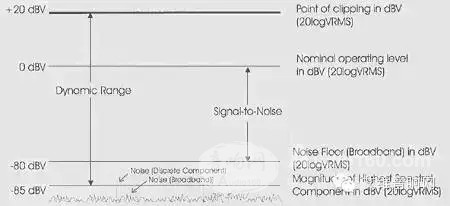
Dynamic Range
The dynamic range of the sound system describes the level difference between the peak value of the signal that can be reproduced in the system (or equipment in the system) and the amplitude of the highest spectral component of the noise floor.
Each electronic device has a dynamic range whose value depends primarily on the power supply limits and the residual noise level of the unit. If the device's noise floor has a strong narrowband component, it will limit the dynamic range of the system.
Signal to noise ratio
The signal to noise ratio refers to the difference between the average signal level and the average noise floor level. In general, a device, the average output level of a common program source signal, the signal peak is usually 10 to 20 dB larger than the average output level.
Therefore, we often operate the mixer near the meter “0†to use the remaining available voltage swing to account for the peak of the program source. The “average†level is very important because our listeners (and test tools) use it to judge the loudness of the program signal.

If a voltmeter is used to measure the RMS value of the residual noise of the device, the signal-to-noise ratio is the difference between this value and the nominal "zero" output level, which is usually expressed in dBV or dBu. This assumes that the device is driven to a “level meter zero readingâ€, usually within this range, and we can get an optimized gain structure to better operate the mixer.
different
The dynamic range of the system (or a component) does not depend on the signal present, it is simply the difference between the maximum undistorted level possible and the highest component of the noise floor (usually A-weighted). The signal-to-noise ratio requires a signal, so it must be measured while the system or component is in use.
A system with a large dynamic range may have a poor signal-to-noise ratio due to operational problems. The dynamic range is used to describe the performance that a system or device can achieve, and the signal-to-noise ratio is generally used to measure the level of actual operation.
Practical application
Through the sound level meter, the A-weighted sound pressure level L of the live performance can be measured at a specific listening position. The method is to raise the sound pressure meter in the air, select the appropriate weighting method, and read the count.
A weighting is usually chosen because it is most sensitive to the most sensitive portion of the spectrum (1-4 kHz) of the human ear. Since most sound level meters are average sound level meters, we can get the average sound level of the show.
Of course, there will be signal peaks in the source that exceed this average, and the sound level meter cannot respond quickly to reading. This “metering lag†differs by approximately 10 dB and may be higher (or slightly lower) depending on the source of the program.
Now, if all the sources on the stage are muted (the microphone is turned on), the rest will be the noise floor of the system, which can be measured in the same way by the same sound level meter. If the sound system is properly designed, the noise floor is the ambient noise picked up by the microphone (not the residual noise of the electronic components).
In a hall with a noise floor of 40 dBA, a typical podium microphone, when the average speaker (71 dBA @ 2 feet) speaks 1 foot away from the microphone, will have a noise ratio of only about 37 dB. If there are ten open microphones and their sensitivity and level settings match the platform microphone, the noise floor is increased by 10 dB because 10 log (number of open microphones) = 10 dB.
Unfortunately, because the sound system cannot be automatically recognized, only the required signal and room noise can be amplified at the same time. The signal-to-noise ratio of the system cannot meet the worst condition when the microphone is turned on. The effect of long-distance pickup is highlighted, and the noise floor of the unwanted microphone in the system cannot be reduced. This phenomenon has become more prominent.

Now, if a powerful singer is in the same system, producing 120 dBA of output into a handheld microphone (not surprising for singers of close-range pickup), the signal-to-noise ratio will reach a more reasonable 80 dB because 120 dBA-40 dBA = 80 dB. Therefore, we often emphasize that good microphone placement techniques are critical to achieving good system performance because it ultimately determines the system's signal-to-noise ratio.
In an auditorium sound system, the lowest SNR standard we use is 25 dB when the system has the largest number of required open microphones (NOM).
In the same system, we assume that the loudest instantaneous sound that the system can produce linearly at the same listening position is 110 dBA.
Even if the system operates at an average level of 90 dBA, it can cope with this level of peaking. The highest program peak depends on the speaker being used and the available amplifiers connected to the speakers. This is an important component of our understanding of the dynamic range of the system.
If the largest noise floor component is the narrow-band “click†caused by the air conditioner, which is 35 dBA measured in the real-time analyzer, the dynamic range of the system is not significant (110 dBA - 35 dBA = 75 dB). The dynamic range can be increased by adjusting the air conditioner to eliminate noise.
As can be seen from the above examples, the dynamic range and signal to noise ratio of an audio system is usually determined by the environment. Because most of the electronic components in the system have a dynamic range of about 100 dB or more, the sound system must not be a weak link when the sound finally reaches the audience. A professional audio system with an electronic component dynamic range of at least 96 dB when all devices are in operation.
Only in the studio or home theater, the noise floor of the device becomes a factor influencing the dynamic range and signal-to-noise ratio of a particular listening position. Therefore, it is possible to design an acoustic system with a very large dynamic range, but due to the room and the like, the overall signal-to-noise ratio is not satisfactory.
One might have designed a system in which each device has a dynamic range of more than 100 dB, but found that in actual operation, the signal-to-noise ratio is greatly reduced due to poor gain structure in system calibration. The most common cause is that the amplifier is driven to maximum and the mixer is operated at -20 dBV to compensate.
When designing a system, we should choose a single device with a large dynamic range, and then use the maximum signal-to-noise ratio to adjust and operate the system for best results.
We have carved a niche amongst the customers for offering broad range of Monocrystalline / Polycrystalline Solar Panels. We provide products to our patrons at affordable rates and have long functional life. These Polycrystalline Solar Panels uses solar energy for charging and uses that energy to function. We are admired amongst the patrons for offering products as per their demands.
Solar Panel,Solar Pv Panel,High Efficient Solar Panel,Solar Power Panels
Delight Eco Energy Supplies Co., Ltd. , https://www.cndelight.com